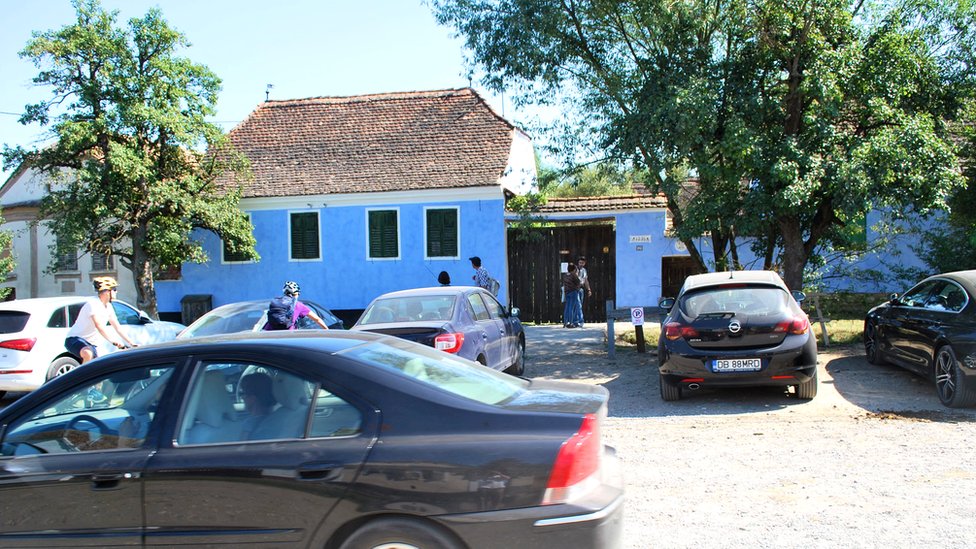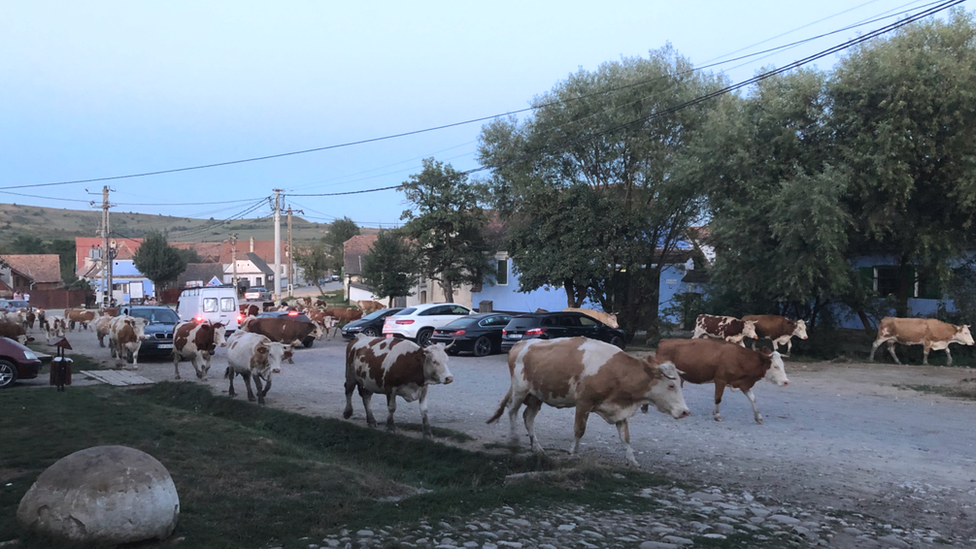By Stephen McGrath
Viscri, Romania
image copyrightAFP
Solely 450 people reside throughout the distant village of Viscri in central Romania, nevertheless in present months it has develop to be overrun by vacationers and their cars.
It is arguably the popular village in Transylvania. Not solely is it a Unesco World Heritage site nevertheless the Prince of Wales has owned a typical farmhouse proper right here since 2006.
The prince fell for the realm’s historic magnificence better than twenty years previously. For years he has helped develop schemes to guard heritage construction and what his native foundation describes as a “way of life unchanged for tons of of years”.
It is a scorching Saturday on the tail end of summer time season, and a delicate stream of cars is submitting into Viscri. There is a path of noise and filth as guests begins to clog up the unsurfaced village roads.
“Take a look on the mud coming from the road!” exclaims Irina Lascu. “It’s truly disturbing us, we won’t even open our dwelling home windows.”
“Cars are going earlier from early morning until late throughout the night time,” says Martin Lascu, who has lived in Viscri since he was born in 1945.


Sitting open air their standard farmhouse, Irina and Martin, every 76, are clearly exasperated by the droves of vacationers descending on their village.
“Everybody appears to be coming because of Prince Charles,” Martin complains.
A unbroken cluster of vacationers lingers open air the prince’s blue dwelling to take photos.
It is a straightforward, standard Saxon farmhouse like another, distinguished by choices corresponding to broad wooden gates and clay roof tiles. Part of the house dates once more to the 18th Century.


Rooms may very well be rented for spherical €100 (£90; $120) per night.
‘A blessing and a curse’
Over the previous couple of years Viscri’s popularity has grown significantly and so too have the vacationer numbers.
Ultimate 12 months, 45,000 vacationers bought admission tickets to Viscri’s distinctive 12th-Century fortified Lutheran Church. That compares with 15,000 in 2015 and 5,000 in 2005.
This 12 months, Covid-19 restrictions on journey abroad have prompted an increase in dwelling tourism, and with it additional cars.


Nonetheless aside from the church, people are moreover drawn by the prince’s dwelling.
Ursula Radu-Fernolend, 35, is a Saxon (descendant of settlers from present-day Germany) whose ancestors have lived in Viscri for a whole bunch of years. She’s moreover a board member for the Mihai Eminescu Perception (MET), which for 20 years has carried out a key perform in preserving the village’s construction.
For her the prince’s have an effect on proper right here has been a “blessing and a curse”.


For years, the prince was a patron of MET until he withdrew his help in 2014.


Teaching and education is obtainable, in what the prince has often known as “a unprecedented part of the world”. He has praised the panorama and biodiversity created by “man’s administration and relationship with nature”.
The BBC approached the muse to the touch upon the rise in vacationers nevertheless it declined.
Trip dwelling hotspot
Over the previous couple of years Viscri has develop to be what Ms Radu-Fernolend describes as a “tick-the-box tourism” trip spot.
As Viscri’s popularity has grown, it has develop to be a trip dwelling hotspot for cosmopolitan foreigners and wealthy Romanians. Moreover it’s a fascinating trip spot for entrepreneurs from Bucharest to open guesthouses and consuming locations.


In consequence, dwelling prices have risen dramatically. A house which may have value €20,000 (£18,000; $23,500) in 2010 may now be supplied for upward of €80,000.
“House prices have exploded,” Ms Radu-Fernolend says. “It’s truly an precise property bubble. Neighborhood to Viscri drives up dwelling prices in neighbouring villages.”
Locals who grew up throughout the area will battle to buy a home, she believes, and worldwide possession could have regulating.
However when there’s one scenario that unites Viscri’s unlikely solid of British royalty, peasant farmers, influential foreigners, NGOs, and entrepreneurs, it’s the vacationers and their cars who disrupt village life.
“We have got 70 chickens and geese, nevertheless there are too many cars on the road now to permit them to out to eat the grass,” villager Cristian Somu complains.


The atmosphere proper now’s additional metropolis theme park than standard farming village.
Ultimate 12 months a particularly constructed automotive park near the doorway to the village was inaugurated using €15,000 of non-public money from 5 native households.
Nonetheless vacationers largely ignore the indications and there is not any requirement to park there anyway.
‘Yearly it’s going to get more durable’
“It’s relatively extra crowded than remaining time we’ve been proper right here two years previously,” says Cosmin Cherees, a 37-year-old engineer from Targu Mures, who’s biking throughout the village alongside along with his family.


“We have got tons of of cars stopping proper right here at weekends, it’s crazy,” says 36-year-old Cristian Radu, Ms Radu-Fernolend’s husband.
He’s working for the submit of native mayor this autumn and is promising to stop vacationers driving into Viscri, till they’re aged or have disabilities.
“I imagine [Viscri] can nonetheless be saved, nevertheless sadly it might effectively’t be executed by people or NGOs anymore, it have to be executed by the native administration.”


This present phenomenon has raised the question of whether or not or not sustainable tourism truly is achievable in Transylvania’s outdated villages. Some are moreover questioning how far some great benefits of tourism truly go.
“Tourism benefits solely people who private consuming locations and guesthouses. It doesn’t help us the least bit,” Irina Lascu says as she picks flowers in her courtyard.
“All of the issues has develop to be costlier proper right here, yearly it’s going to get more durable.”
“Now we have to find a reply,” says Ms Radu-Fernolend, sooner than heading out to put up election posters to help her husband’s mayoral advertising marketing campaign.
“If the authenticity goes then we’re solely a museum, and we truly don’t have to develop to be that.”








